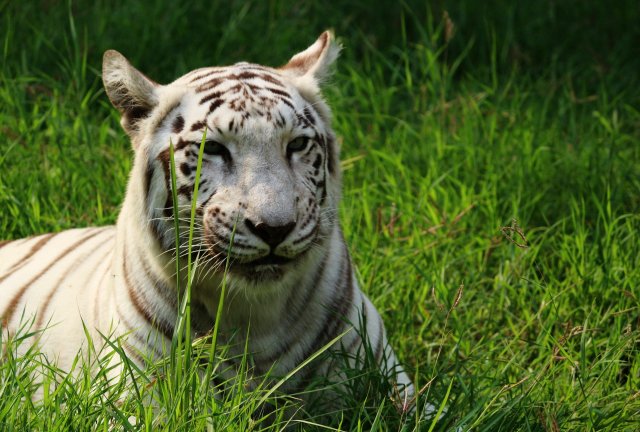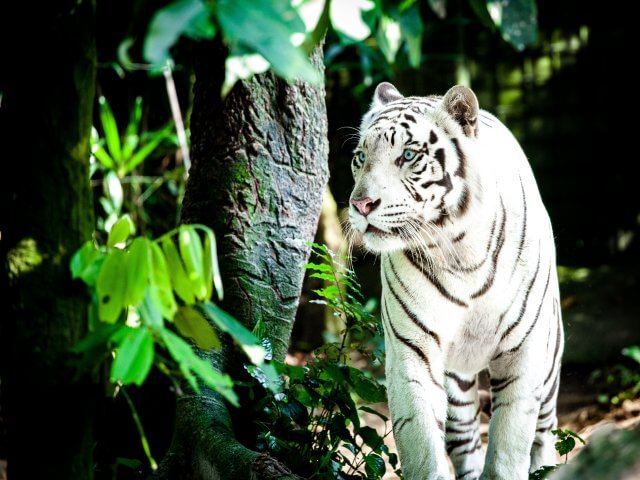The Enigmatic Beauty of Majestic White Tigers: A Captivating Encounter
The Majestic White Tigers
White tigers, with their striking appearance and enigmatic beauty, have captivated the hearts and minds of people around the world. These majestic creatures, with their snow-white fur and piercing blue eyes, evoke a sense of awe and wonder. In this article, we will explore the fascinating world of white tigers, their unique characteristics, and the challenges they face in the wild.
The Origins of White Tigers
White tigers are not a separate species or subspecies; rather, they are a rare color variation of the Bengal tiger (Panthera tigris tigris). The white coloration is caused by a recessive gene known as the chinchilla gene, which inhibits the production of pigment in the fur. This genetic mutation occurs naturally in the wild, but white tigers are extremely rare, with only a few individuals existing in the wild today.
One of the most famous white tigers was Mohan, captured in India in 1951. Mohan became the foundation for the captive white tiger population, as he was bred with normal orange tigers to produce more white offspring. However, this selective breeding has led to a high prevalence of genetic abnormalities in captive white tigers, such as crossed eyes, cleft palates, and immune system deficiencies.
The Significance of White Tigers
White tigers hold a special place in many cultures and mythologies. In Indian mythology, the white tiger is associated with power, strength, and protection. It is considered a sacred animal and is often depicted as the vehicle of the goddess Durga. In Chinese culture, the white tiger is one of the four celestial animals and represents the west and the autumn season.
White tigers also play a crucial role in conservation efforts. They serve as ambassadors for their species, drawing attention to the plight of tigers in the wild. By raising awareness about the threats faced by tigers, including habitat loss and poaching, white tigers help garner support for conservation initiatives and inspire people to take action.
The Challenges Faced by White Tigers
White tigers face numerous challenges in the wild, primarily due to their unique coloration. Their white fur makes them highly visible to prey and predators alike, making it difficult for them to hunt and hide effectively. In their natural habitat, white tigers would struggle to survive and reproduce, as their coloration puts them at a disadvantage.
Furthermore, the demand for white tigers in captivity has led to unethical breeding practices and the proliferation of genetic abnormalities. Many white tigers in captivity suffer from health issues and have a reduced lifespan compared to their orange counterparts. It is essential to prioritize the well-being and conservation of tigers as a whole, rather than focusing solely on the allure of white tigers.
Conservation Efforts and Success Stories
Despite the challenges they face, there have been successful conservation efforts aimed at protecting white tigers and their habitats. One such example is the work of the Global White Tiger Conservation Society (GWTC), which focuses on preserving the genetic diversity of white tigers and promoting responsible breeding practices.
The GWTC has established protected areas for white tigers in their natural habitats, ensuring that they have sufficient space to roam and thrive. They also collaborate with local communities to raise awareness about the importance of tiger conservation and provide alternative livelihood options to reduce human-wildlife conflicts.
Case Study: Rewa White Tigers
The Rewa white tigers, native to the Rewa district in Madhya Pradesh, India, are a famous success story in white tiger conservation. The first white tiger cub, named Mohan, was discovered in the forests of Rewa in 1951. Mohan’s descendants have played a crucial role in preserving the white tiger gene pool.
The Rewa white tigers have been successfully reintroduced into the wild, contributing to the overall population of Bengal tigers. This achievement highlights the importance of preserving the genetic diversity of white tigers and their potential for reintroduction programs.
Conclusion
Majestic White Tiger: White tigers are undoubtedly captivating creatures, with their unique appearance and symbolic significance. While they may be rare and beautiful, it is crucial to remember that they are a product of genetic mutations and selective breeding. The focus should be on conserving tigers as a whole, rather than solely on the allure of white tigers.
Through conservation efforts and responsible breeding practices, we can ensure the survival of white tigers and their orange counterparts. By protecting their habitats, raising awareness, and supporting organizations dedicated to tiger conservation, we can secure a future where these majestic creatures continue to roam the wild, enchanting us with their enigmatic beauty.
Escape to Nature’s Haven: Turpentine Creek Wildlife Refuge in Eureka Springs, AR





